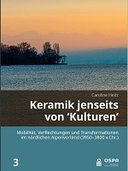Explore

Mobility is fundamental to forms of social configurations. But what role did spatial mobility play in the past? Regarding prehistoric periods, such as the Neolithic, we still do know little about this. That also applies to the settlement areas of the northern Alpine Foreland. The wetland settlements there were labelled UNESCO World Heritage in 2011. With their excellently preserved remains in lakes and bogs they provide a unique research basis. The dendrochronologically dated settlements open a rare possibility to approach cultural, social, and economic processes based on a high temporal and spatial resolution. In the present volume, this is achieved based on pottery from contemporaneously dated settlements on Lake Zurich and Lake Constance from the period between 3950 and 3800 BC.
Process philosophical considerations on the (trans)formation of 'things' are combined with relational social theoretical concepts such as the habitus theorem to form a praxeological approach. The latter serves as the epistemological basis of the newly elaborated mixed method research methodology, which allows for a deeper understanding of mobility, social relations and configurations as well as transformations. Qualitative methods (classification of vessel designs) is utilised to understand pottery production practices from the perspective of the makers and quantitative methods (cluster analysis of vessel features) can be used to analyse transregional structures of ceramic consumption. Accordingly, patterns of spatial mobility and far-reaching relationships of settlement communities become apparent based on such material entanglements. Mobility-related appropriation phenomena and change in pottery practices can be approached in the rhythm of individual decades. Furthermore, the combination of a subjectivist with an 'objectified' stance during the research process based on Pierre Bourdieu's epistemology, the praxeology, leads to an epistemological, metamodern 'third way' that mediates between the realism of modernity (processual archaeology) and the constructivism of postmodernity (post-processual archaeology). Finally, the research results deconstruct the common social models following the cultural-historical paradigm, which conceptualized 'cultures' as supposedly static, homogeneous, spatially distinct entities. Instead, the pottery points to translocal social configurations that related settlements in the northern Alpine Foreland with each other in the 4th millennium BC.
This book is included in DOAB.
Why read this book? Have your say.
You must be logged in to comment.
Rights Information
Are you the author or publisher of this work? If so, you can claim it as yours by registering as an Unglue.it rights holder.Downloads
This work has been downloaded 48 times via unglue.it ebook links.
- 48 - pdf (CC BY-NC) at Unglue.it.
Keywords
- Archaeology
- Archaeology by period / region
- Ceramics
- Classification
- Habitus
- Humanities
- mixed method research
- mobility
- neolithic
- Praxeology
- Prehistoric archaeology
- prehistoric lakeside settlements
- reflexive archaeology
- thema EDItEUR::3 Time period qualifiers::3B Prehistory
- thema EDItEUR::N History and Archaeology::NK Archaeology::NKD Archaeology by period / region
- transformation
- UNESCO worldheritage
Links
DOI: 10.5281/zenodo.7408967Editions

